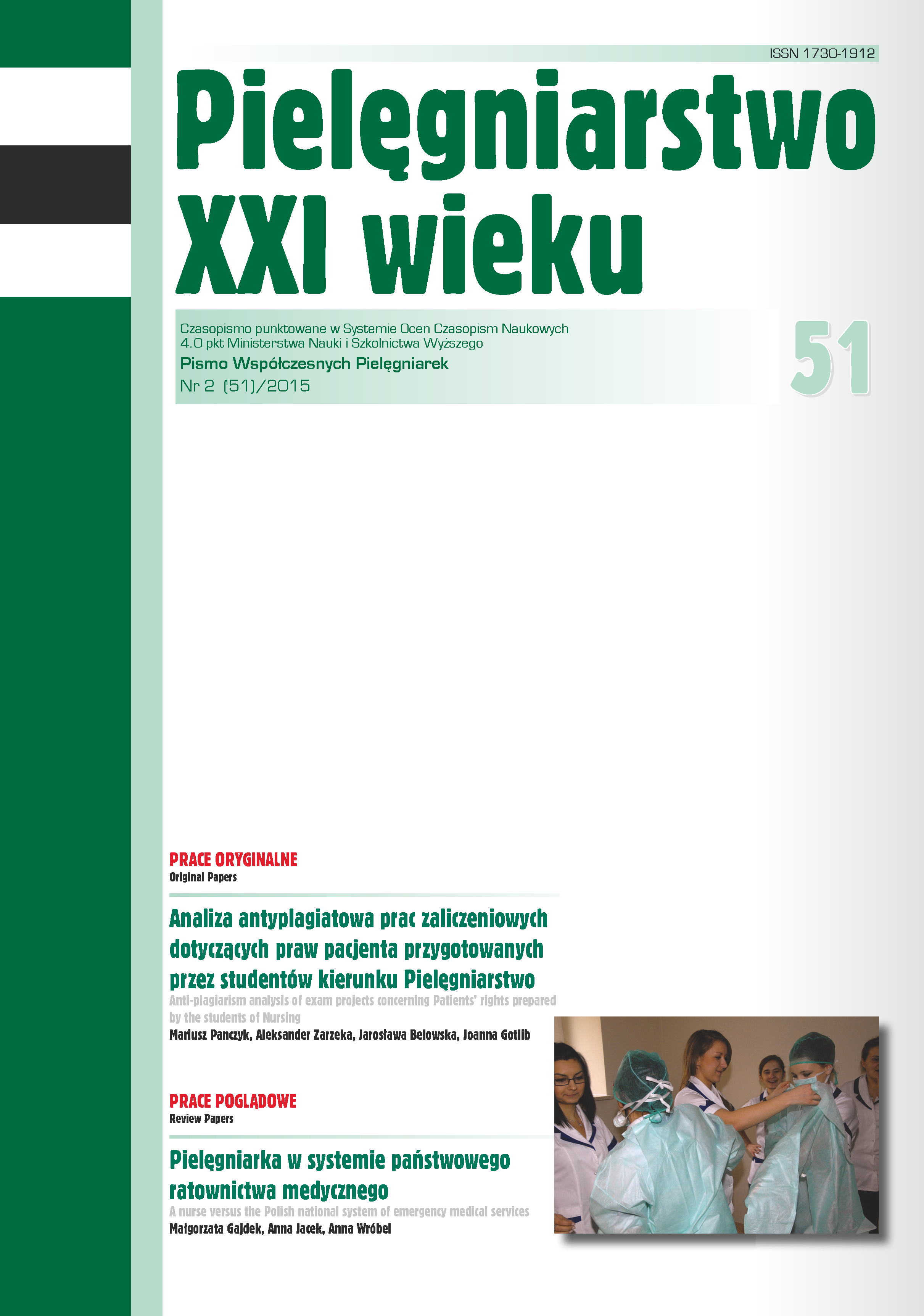Risk of attrition from Bachelor’s degree of Nursing programme – predictive evaluation
DOI:
https://doi.org/10.12923/p21w-2015-2/22Keywords:
nursing education research, postgraduate nursing education, educational measurement, school admission criteriaAbstract
RISK OF ATTRITION FROM BACHELOR’S DEGREE OF NURSING PROGRAMME – PREDICTIVE EVALUATION
Aim. Measuring the dropout risk among the 1st degree students of the Nursing Department at the Faculty of Health Sciences at the Medical University of Warsaw (MUW).
Materials and methods. 887 students (age average 20.0 ± 2.87; 90% women) who undertook full-time studies of the 1st degree at the Nursing Department at the Faculty of Health Sciences at MUW. A model on non-linear estimation for the function of logistic regression with the odds ratio (OR) estimated for each predictor was used in evaluating predictive factors that are of potential influence on the risk of attrition.
Results. Three out of four socio-demographic factors significantly heightened the dropout risk: gender – male (OR = 3.035), Warsaw as a place of completing high school (OR = 1.598) and having passed the older type of the maturity exam (OR = 1.536). The following criteria of admission can be deemed as relevant predictors of failure: Polish language (OR = 1.021) and an additional subject (OR = 1.011) (two out of three).
Conclusions. The results of the study show that the current admission criteria fail, particularly when it comes to admitting students with a potentially high risk of dropping out. It is necessary to monitor and register the reasons of dropping out / being removed from the list of students further, so as to assess the risk of attrition more adequately in the future.
References
1. Waters A. What a waste: Nursing Standard’s investigation into attrition rates from pre-registration courses produced some startling findings. Nurs. Stand. 2006; 20(23): 14-7.
2. Banks P, Kane H, Rae C, et al. Support for nursing and midwifery students: a special case? Nurse. Educ. Today. 2012; 32(3): 309-14.
3. Seago JA, Spetz J. Admission Policies and Attrition Rates in California Community College Nursing Programs. University of California at Berkeley: California Policy Research Center; 2003.
4. Wilson R, Eva K, Lobb DK. Student attrition in the Ontario midwifery education programme. Midwifery. 2013; 29(6): 579-84.
5. Andrew S, Salamonson Y, Weaver R, et al. Hate the course or hate to go: semester differences in first year nursing attrition. Nurse. Educ. Today. 2008; 28(7): 865-72.
6. Gillen S. Is enough being done to reduce undergraduate attrition rates? Nurs. Stand. 2012; 27(8): 12-3.
7. Sabin M, Taylor R, Tilley C. Untangling a complex issue: An overview of initiatives to support nursing and midwifery student recruitment, selection and retention in Scottish Universities. Nurse. Educ. Today. 2012; 32(4): 469-74.
8. White J, Williams WR, Green BF. Discontinuation, leaving reasons and course evaluation comments of students on the common foundation programme. Nurse. Educ. Today. 1999; 19(2): 142-50.
9. Cameron J, Roxburgh M, Taylor J, et al. An integrative literature review of student retention in programmes of nursing and midwifery education: why do students stay? J. Clin. Nurs. 2011; 20(9-10): 1372-82.
10. Pryjmachuk S, Easton K, Littlewood A. Nurse education: factors associated with attrition. J. Adv. Nurs. 2009; 65(1): 149-60.
11. Day R, Paul P, Boman J, et al. Proposal to support the strategic plan to implement the Canadian nursing advisory committee recommendations. Ottawa Ontario: Canadian Nurses Association; 2005.
12. Mulholland J, Anionwu EN, Atkins R, et al. Diversity, attrition and transition into nursing. J. Adv. Nurs. 2008; 64(1): 49-59.
13. Deary IJ, Watson R, Hogston R. A longitudinal cohort study of burnout and attrition in nursing students. J. Adv. Nurs. 2003; 43(1): 71-81.
14. Taylor R. Creating a connection: tackling student attrition through curriculum development. J. Fur. High. Educ. 2005; 29(4): 367-74.
15. McCallum J, Donaldson JH, Lafferty P. Can an interview score sheet assist with student selection onto the bachelor of science/diploma of higher education (adult) nursing programme? Findings from a pilot study. Nurse. Educ. Today. 2006; 26(7): 586-92.
16. McCarey M, Barr T, Rattray J. Predictors of academic performance in a cohort of pre-registration nursing students. Nurse. Educ. Today. 2007; 27(4): 357-64.
17. Ferguson E, James D, Madeley L. Factors associated with success in medical school: systematic review of the literature. BMJ. 2002;324(7343):952-7.
18. Kevern J, Ricketts C, Webb C. Pre-registration diploma students: a quantitative study of entry characteristics and course outcomes. J. Adv. Nurs. 1999; 30(4): 785-95.
19. Zwick R, Greif Green J. New Perspectives on the Correlation of SAT Scores, High School Grades, and Socioeconomic Factors. J. Educ. Meas. 2007; 44(1): 23-45.
20. Jowett S, Walton I, Payne S. Challenges and Change in Nurse Education: A Study of the Implementation of Project 2000: Executive Summary. Slough: National Foundation for Educational research in England and Wales; 1994.
Downloads
Published
Issue
Section
License
Copyright (c) 2024 Mariusz Panczyk, Aleksander Zarzeka, Jarosława Belowska, Joanna Gotlib (Autor)

This work is licensed under a Creative Commons Attribution 4.0 International License.




